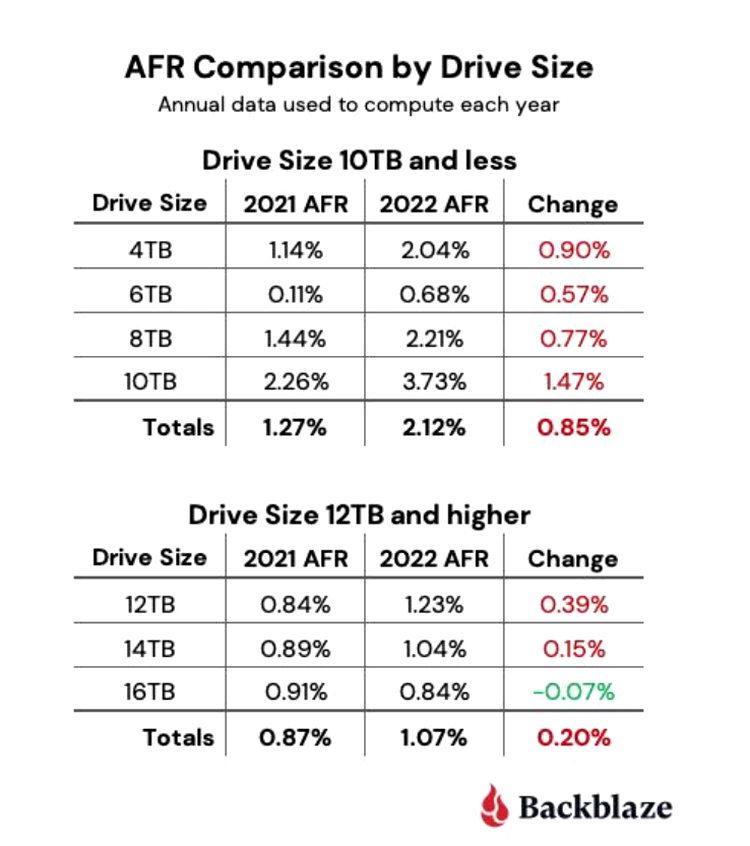The best hard drive to buy in 2023 is confirmed by one of the largest cloud storage service providers, based on a pool of 20,393 drives operated 24/7.
Blackblaze has published its Hard Drive Reliability Report for January to December 2022, detailing the cumulative failure rate of several consumer HDD models, bearing the signatures of brands such as Western Digital, Seagate, Hitachi and Toshiba.
Giving consumers a rare opportunity to see not only which manufacturer offers the best hard drives, but also which exact models we might want to steer clear of, Backblaze is a departure from other hard drive companies that are content to simply publish a general ranking of manufacturers, or keep this data secret to avoid damaging their good relationships with suppliers.
With a reasonable degree of accuracy, the statistics were based on 230,921 hard disks, totalling 78,760,434 cumulative days of operation. In total, 2963 defective HDDs ended up in the recyclable waste bin, representing 1.37% of all devices in service. Compared to previous years, the proportion of defective HDDs is slightly increasing, signifying a greater focus on cost reduction as HDD manufacturers try to compete in the market for cheaper and better performing NAND Flash storage solutions each year.
The results are all the more interesting to watch as Backblaze uses ordinary consumer hard drives, but subjected to a heavy-duty regime that can highlight models prone to accelerated wear and tear or other design problems quite quickly.
Totaling 38,182 drives, the Toshiba MG07ACA14TA series of hard drives (14TB capacity) is the most common in the company’s racks, with an estimated annual failure rate of 1.01% per year being reasonable under heavy use, well above what we’d find in a typical PC. Counting 20,393 drives, the Seagate STI6000NM001G (16TB) is another safe choice, with a failure rate of 0.86% per year, but reported on a slightly smaller test group. At the other end of the scale is another Seagate model, the STI4000NM0138 (14TB), with a defect rate of 5.70% based on a relatively small batch of 1519 drives.
Of the non-Seagate hard drives, the only one that attracts attention with an above-average failure rate is the Hitachi HUH728080ALE604 (4TB) with an estimated annual failure rate of 5.27%, but based on only 94 drives put into service.
Another interesting breakdown weighs storage capacity against failure rate, showing that simply choosing the highest capacity HDD increases both the amount of data that can be lost from a single incident and the likelihood of that incident occurring. Apparently, the optimal choice for a 3.5-inch form factor hard drive is 6TB capacity, with the failure rate measured at 0. 57% being almost three times lower than for 10TB capacity models. However, if budget allows, then choosing a 16TB model implies only a slightly higher failure rate.



 What’s happening with AI? Researcher explains why you can look forward to more creative NPCs, competition for ChatGPT and hot dog tomatoes
What’s happening with AI? Researcher explains why you can look forward to more creative NPCs, competition for ChatGPT and hot dog tomatoes Cowboy launches new on-demand service: That’s what’s inside
Cowboy launches new on-demand service: That’s what’s inside The new 4K Fire TV stick is now brutally reduced and transforms your old television into a smart TV
The new 4K Fire TV stick is now brutally reduced and transforms your old television into a smart TV The best mouse I’ve ever had, convinces me for gaming, work and home office and is different than all its predecessors!
The best mouse I’ve ever had, convinces me for gaming, work and home office and is different than all its predecessors! The first smart glasses suitable for everyday use that you can buy
The first smart glasses suitable for everyday use that you can buy